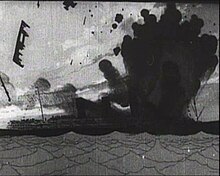
Back The Sinking of the Lusitania Catalan The Sinking of the Lusitania Danish The Sinking of the Lusitania German The Sinking of the Lusitania French The Sinking of the Lusitania ID The Sinking of the Lusitania Italian ルシタニア号の沈没 Japanese 루시타니아 호의 침몰 Korean The Sinking of the Lusitania NB Zatopienie Lusitanii Polish
| The Sinking of the Lusitania | |
|---|---|
 A still from the film showing the RMS Lusitania engulfed in smoke after being torpedoed. | |
| Directed by | Winsor McCay |
| Produced by | Winsor McCay Production manager: John D. Tippett |
| Animation by | Winsor McCay Animation assistance: John Fitzsimmons William A. Adams[1] |
| Distributed by | Jewel Productions (unc.) Universal Films |
Release date |
|
Running time | 12 minutes |
| Country | United States |
| Language | Silent with English intertitles |
The Sinking of the Lusitania (1918) is an American silent animated short film by cartoonist Winsor McCay. It is a work of propaganda re-creating the never-photographed 1915 sinking of the British liner RMS Lusitania. At twelve minutes, it has been called the longest work of animation at the time of its release. The film is the earliest surviving animated documentary and serious, dramatic work of animation. The National Film Registry selected it for preservation in 2017.
In 1915, a German submarine torpedoed and sank the RMS Lusitania; 128 Americans were among the 1,198 dead. The event outraged McCay, but the newspapers of his employer William Randolph Hearst downplayed the event, as Hearst was opposed to the U.S. joining World War I. McCay was required to illustrate anti-war and anti-British editorial cartoons for Hearst's papers. In 1916, McCay rebelled against his employer's stance and began work on the patriotic Sinking of the Lusitania on his own time with his own money.
The film followed McCay's earlier successes in animation: Little Nemo (1911), How a Mosquito Operates (1912), and Gertie the Dinosaur (1914). McCay drew these earlier films on rice paper, onto which backgrounds had to be laboriously traced; The Sinking of the Lusitania was the first film McCay made using the new, more efficient cel technology. McCay and his assistants spent twenty-two months making the film. His subsequent animation output suffered setbacks, as the film was not as commercially successful as his earlier efforts, and Hearst put increased pressure on McCay to devote his time to editorial drawings.
- ^ Canemaker 2005, p. 188.